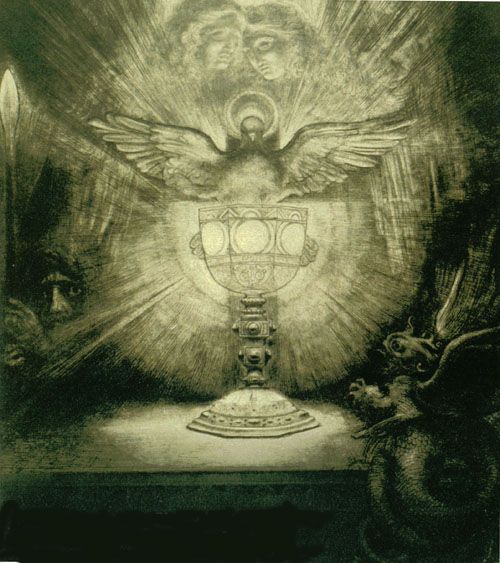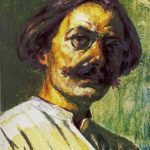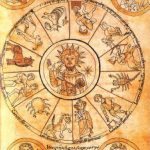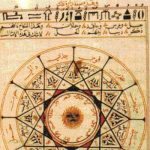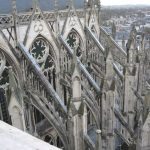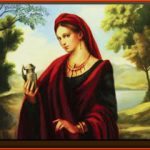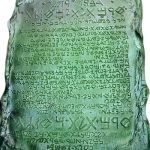Chapter Eleven
Our word crusade comes from the Spanish word cruzada, meaning “marked with the cross.” The Crusaders were indeed marked by the cross in more than just the design emblazoned on their tunics. They were inflamed by a new vision of Christianity, one in which there was work to do. The kind of work the semi-barbarian kings of the west understood best, warfare. The First Crusade stands as a kind of human monument to belief in the end of the world.
Sylvester and Otto III had tried to build a new unified world state from the fragments of the ancient world. They saw this state, which perhaps was meant to include the Fatimids as well, as a bulwark against the rising tide of barbarian Asiatics. In central Europe, these refugees appeared as Kazars and Jews, in Asia Minor, they were known as the Seljuk Turks. These migratory pressures threatened the Eastern Empire at Constantinople as well the Fatimid control of Palestine. The western Empire, reviving under Otto III and Sylvester, created the Christian kingdoms of eastern Europe, Poland, Czechoslovakia and Hungary, as a barrier to further invasions from the east.
United, the three parts of the early medieval world, the two Romes and the Fatimids, could have resisted not just the pressure of the Turks but that of the later Mongol invasions. As it happened however, the Seljuk Turks conquered Palestine in 1071 and threatened the stability of the entire world when they turned on Constantinople. After a disastrous defeat, the Eastern Empire made a humiliating peace and was left with very little of Asia Minor. The Empire had been saved, but the way to Constantinople was open to the next wave of Turkish invaders.
At this point, a mysterious figure breaks the surface of anonymity to begin his career as one of the principle movers and shakers of the First Crusade. In 1088, Peter the Hermit was an unknown monk belonging to one of the clerical or chronicling orders. Curiously, its name has not come down to us, but his appearance on the scene suggests connections at the very highest level. That year, Peter the Hermit traveled from Jerusalem to deliver an impassioned plea from Simeon, the Patriarch of Jerusalem, to the newly elected Pope Urban II. This plea, for aid from the west and its offer of a reconciliation between the churches would certainly not have been entrusted to a simple itinerant preacher. The Patriarch’s letter caused years of intense discussion within the church and set the tone for Urban’s Papacy.
In early 1095, Alexius I, the eastern Emperor, sensing weakness in the current Seljuk in-fighting, sent an envoy to Pope Urban II and the council at Piacenza asking for military aid from the west. Urban II was influenced by the opportunities these entreaties provided. Perhaps the old Sylvestrian scheme of a united world state could actually be achieved. It was a risk, but it just might be a risk worth taking. Urban departed on a six-month long tour of northern Italy and southern France collecting support. In August, from Le Puy in southern France, a church council was called for November at Clermont in Auvergne, not far from the small monastary of Aurillac.
Exactly what Urban had in mind and what he expected from the Clermont synod is unclear. He seems to have intended a military expedition, not unlike those he had already sanctioned in Moslem Spain. What he got was something entirely different.
Urban II, born Odo of Chatillon-sur-Marne and a former Prior of Cluny, was a man of broad views, an experienced organizer and a skilled diplomat dedicated to his predecessor’s, Gregory VII, program of reforms. Unlike Gregory, whose fiery intensity seemed to leave no one untouched, Urban was supremely human, tall, handsome, socially at ease and aristocratically distinguished. His overall goal was to reform the western church and re-unite it with the eastern church to create a truly catholic, or universal, Christianity. Toward that end, Alexius I’s request for military aid looked like a major breakthrough. Urban was also influenced by the Peace of God movement and saw the call to arms against the “accursed race, wholly alienated from God,” as he called the Turks in his speech to the crowd at Clermont, as a way to mitigate and channel the violence of the European nobility.
On that crisp Tuesday morning, the 27th of November, 1095, thousands had gathered to hear the Pope’s pronouncement. Itinerant monks and lay preachers had spread the word of the public session for months. When the day arrived, the crowd was far too great for the cathedral, so the meeting was held outdoors, in a field near the eastern gate of the city. After the multitude had gathered, Urban II climbed up on a raised platform and addressed them.
Four contemporary chroniclers reported Urban’s words. One of them, Robert the Monk, claimed to have been there and heard the words as Urban spoke them. It is his version which we will paraphrase. He tells us that Urban began by calling on the Franks — “O race of Franks! race beloved and chosen by God!” Robert records — to come to the aid of their brethren in the east. Eastern Christendom had appealed for aid, the Turks were advancing into Christian territory, killing and desecrating as they came. Urban stressed the holiness of Jerusalem and the suffering of the pilgrims who journeyed there. Having painted a somber picture of conditions in the east, Urban made his appeal: Let western Christendom march to the rescue. Let rich and poor march together, and leave off killing each other for the greater good of killing the godless Turks. This was the work of God, Urban declared, and there would be absolution and remission of sins for those who died in this most holy of causes. There must be no delay, let everyone be ready to march by the summer. God will be their guide.
Urban, speaking in French to his fellow Frenchmen, rose to levels of eloquence that the Latin of the chroniclers can not convey. The enthusiasm however was beyond anything that even Urban had expected. Roars of “Deu li volt,” or God wills it, swept through the crowd even before Urban finished his speech. At its conclusion, the Bishop of Le Puy fell to his knees, begging permission to join the expedition. Thousands followed his example.
The Pope was caught off guard. No plans had been yet made, certainly no arrangements for a mass movement such as erupted over the winter of 1095-96. While Urban re-assembled his bishops to make the political arrangements, a group of wandering evangelists began to spread the word. Foremost among them was Peter the Hermit.
The shadowy figure of Peter the Hermit, an enigma even to his contemporaries, haunts the story of the First Crusade. We have seen him in 1088 delivering a message from the Patriarch of Jerusalem to Pope Urban. Later, historians would doubt this story because of Peter’s humble background and apparent insignificance. And yet, there is something about the mysterious rabble rousing monk that suggests powerful connections and important supporters. Piecing together his career gives us a glimpse of the hidden machinations behind the Crusades.
Peter was born around the middle of the 11th century in Picardy, possibly near Amiens. Before becoming a monk, Peter was a minor noble who owed his fief to Eustace de Boulogne, Godfroi de Bouillon’s, the future king of Jerusalem’s, father. Sometime after 1070, Peter joined a monastery in the Ardennes, where for a few years he served as tutor to the young Godfroi. Sometime after 1080, he departed on a pilgrimage to Jerusalem, where he apparently stayed until his mission to Rome in 1088. Nothing is known of his where abouts until the winter of 1095 when he began to preach the new crusade at Bourges, in the province of Berry. He apparently did not attend the church council at Clermont.
Keeping in mind the work of Pope Sylvester II and his various chronicling orders, a pattern emerges from the shadows of Peter’s story. Peter joined the only group of monks in the Ardennes, those at Orval, near Stenay, a site with rich Merovingian connections, whose patron was Godfroi’s aunt and foster mother. This group of monks were part of a mysterious order of chroniclers from Calabria in northern Italy who seemed mostly concerned with researching the bloodline of the Duke of Lorraine, Godfroi’s family.
If these monks were part of the chroniclers established in many different forms by Pope Sylvester, then it is easy to understand the many curious twists in Peter’s career, such as his long sojourn in Jerusalem. He could have been transferred to the order’s chapter there, the one established outside the city in a basilica given to them by the mad Caliph al-Hakim. This makes sense in light of Peter’s later diplomatic mission. Only a high ranking member of a clerical order, founded by the Pope himself, would be a fitting enough representative to deliver messages from the Patriarch of Jerusalem and the eastern church.
Peter’s silence between 1088 and 1095 may have been enforced by the dictates of his order. Only after the church council, and its demonstration of mass approval, was Peter the Hermit given permission to begin his own crusade.
Before the year was out, Peter was in Berry preaching his own version of the Holy War, one in which the poor and the pious in Christ would sweep ahead of the nobles and conquer Jerusalem with only God’s assistance. Guibert of Nogent, who knew him personally, gives us a glimpse of Peter’s authority: “Everything he said or did, it seemed like something half-divine.” This unkempt, fiery tempered monk, who habitually went about barefoot and in filthy rags, was also a spell-binding orator capable of moving masses of people to extremes of emotion. They took the cross by the thousands and followed this Rasputin-like character down the long road to the east.
In January, Peter left Berry and traveled through Orleans and Champagne, gathering crowds whenever he stopped. In Lorraine, he visited his old monastery near Orval and discussed the crusade with his old pupil, Godfroi de Bouillon. No record remains of their conversations, but something convinced Godfroi to join the crusade. By spring, as Peter collected his people’s army in Cologne, Otto III’s old capital, Godfroi took the cross at Amiens. Unlike the other nobles who participated in the First Crusade, Godfroi renounced his fiefs, sold his goods and moved with his brothers to the Holy Land. Godfroi did not intend to return, perhaps he already saw himself as the chief candidate for King of Jerusalem.
Godfroi of course wasn’t the only noble of ancient lineage taking the cross that summer. The group was officially under the leadership of the Bishop of Le Puy, Adhemar, as papal legate, and included Raymond of Toulouse, an old crusader from the Spanish wars, Hugh of Vermandois and Robert II of Flanders along with Robert, the Duke of Normandy and his brother-in-law, the hapless Stephan, Count of Blois. In September of 1096, word reached Urban that the Normans of southern Italy and Sicily were ready to take up the cross. These Normans, led by Bohemund and his nephew Tancred, brought the most experienced and capable soldiers in Europe to the crusading movement. Bohemund’s father, Roger of Guiscard, had almost conquered Constantinople itself a few years before, and the Normans scented opportunity in the call to the east.
The long story of the First Crusade, and its People’s Crusade prologue, is told in many places. The best of all the histories is still Sir Steven Runciman’s multi-volume work on the entire crusading era. We recommend it to any one wanting the complete story. For our purposes, we will concentrate on Peter the Hermit and his student, Godfroi de Bouillon.
The People’s Crusade, after a torturous journey across central Europe, arrived at the gates of Constantinople, in the spring of 1097, as a hungry and uncontrollable mob. The Emperor shipped them over to the Asian side of the straits, where they rashly attacked a Turkish stronghold and were annihilated. Peter the Hermit wisely stayed in Constantinople and therefore survived. He was still there, and held in some honor, when the next wave of crusaders arrived.
As the crusading princes gathered in Constantinople, Peter joined them with the remnants of his army. Perhaps because of his old association with Godfroi, by this point the acknowledged leader of the crusade, Peter was respected as a visionary and councilor to the group. He marched on with them to Antioch, where he played a part in the drama of the Holy Spear. After Antioch, Peter joined with the Tafars, or poor ones, in calling for a speedy advance on Jerusalem.
After the fall of Jerusalem, Peter was one of the secret council, perhaps even its leader, who chose Godfroi as the King of Jerusalem. Godfroi declined the title, preferring instead that of Defender of the Holy Sepulchre, but in 1100 his younger brother Baldwin accepted it readily. During Godfroi’s reign, Peter the Hermit was held in such high regard that when the crusaders pushed on to Ascalon, he was left in charge of Jerusalem. Before Godfroi left Jerusalem, almost his sole official act as king was to reconfirm the charter of an abbey on Mount Sion, south of the city and outside of its walls, and order its immediate fortification.
Peter the Hermit survived until 1115 and divided his time between the court at Constantinople and the newly re-built abbey on Mount Sion, where he is believed to have died. The great French historian of the Crusades, Rene Grousset, commented that Godfroi’s throne was founded on the rock of Sion, and that it indicated a royal tradition equal to that of the reigning dynasties of Europe. Grousset however, does not explain his comment, leaving of us to speculate on its meaning.
Urban’s plans of military aid for the eastern church was subverted by Peter the Hermit and his followers’ insistence on a people’s crusade. This popular impetus swept control of the expedition out of papal hands and into the hands of the military and political leaders on the spot. When Adhemar, the papal legate, died at Antioch, a council of such leaders took over. Peter was a part of that council and was perhaps instrumental in electing Godfroi king. The crusade changed from a papal expedition to something different, a popular movement with millenarial expectations and Peter the Hermit was at the heart of that change.
If Peter was indeed a high ranking member of one of the surviving chronicling orders started by Sylvester II, who were charged with researching the Merovingian bloodline, then his influence becomes readily understandable. Sylvester’s chronicling orders had been working for almost a century to create a new kingdom of Jerusalem, and then, suddenly, the means were at hand. All that was needed was a candidate for king whose bloodline was such that all the kings of Europe could acknowledge him as overlord.
Godfroi may have filled the bill because the chroniclers believed him to be a descendent of the lost line of Merovingian kings, and therefore a direct descendent of Jesus himself. That would in fact, if proven, make him the rightful king of Jerusalem, and perhaps of the world. It would at least fulfill a great many apocalyptic expectations and could be seen as the first steps toward the Kingdom of Heaven on earth so beloved of the Chilaists.
The rock of Sion could be Peter, petros or rock in Latin, the Hermit of the Order of Sion, to whom both Godfroi and Baldwin directly owed their throne. So much more so if Peter, as the official representative of Sion and the chroniclers, was their guarantor as legitimate descendants of Jesus. Mount Sion itself seems the likeliest candidate for the location of the original order. Al-Hakim donated to Sylvester’s chroniclers a Greek Church somewhere outside the walls, but still close enough for access to the city. Mount Sion, which contains the ruins of a 4th century basillica rebuilt in the early 11th century, seems the most obvious choice. A group of monks were apparently still there in 1099, and may have played a part in the fall of the city. This “rock of Sion” and its connections in Europe, could also be considered the foundation of the dynasty. But, as we will see, there could in fact be another “rock of Sion” on which the Kingdom of Jerusalem was built.
The authors of Holy Blood, Holy Grail deserve credit for their discoveries concerning the role played by the Order, or Priory, of Sion in the creation of the Templars. Just as they were right about the unusual and probably Jewish Christian origins of the Merovingians, they were correct, as far they went, about the mysterious precursors to the Templars who occupied Mount Sion. While not going far enough back to uncover the pivotal role played by Pope Sylvester II, Holy Blood, Holy Grail’s facts about the Order of Our Lady of Sion are both correct and suggestive.
By the time the supposed Templars arrived on the scene, in 1118 or ’19, the Order of Sion was already a powerful group with close ties to the Kings of Jerusalem. These ties were based, in all probability, on the Order’s knowledge of the dynasty’s true heritage. Therefore the secret at the heart of the Templars’ sudden rise in the medieval world was due to more than just, as Holy Blood, Holy Grail suggests, a knowledge of Jesus’s descendants. Once again, something more is involved.
The missing piece, as we noted in the last chapter, is alchemy. The Merovingians, whether or not they were descended from Christ, were indeed practical alchemists and wizard kings. Sylvester II, the Hermetic Pope, was on the verge of recovering the secret when power politics overwhelmed him. The motivation for the First Crusade, deeply hidden behind religious and political rationalizations, was actually the search for and recovery of the secret. A Merovingian king on the throne of Jerusalem was just the first step in the millenium’s events. Next would come the rebuilding of the Temple, based on the Philosopher’s Stone, the stone the builders’ rejected.
This was the true mission of the Templars, and Holy Blood, Holy Grail is partly correct. The secret did involve the bloodline. Curiously, the authors of Holy Blood, Holy Grail rarely mention alchemy, even though several supposed Grand Masters of Sion are prominent alchemists. Only once in the entire book does alchemy come to the forefront. In discussing the Templars and their mysterious “head,” even the authors of Holy Blood, Holy Grail are forced to make alchemical allusions. Whatever the Templars were trying to accomplish, the secret of alchemy was the central and critical component of their plans.
By the end of the second decade of the 12th century, most of the veterans of the First Crusade were dead. Godfroi de Bouillon, exhausted by his labors, died, the year after the fall of Jerusalem, in 1100. Peter the Hermit died in 1115 and Baldwin I, Godfroi’s brother, followed him in 1118. Things were changing in Outremer, the land beyond the sea, as the Franks called Palestine. Latin kingdoms, including Jerusalem, had been established from Syria to Gaza, but if they were to remain independent, it was time to look to their collective security.
With this in mind, soon after his coronation, Baldwin II, cousin of Godfroi and Baldwin, legitimized the only standing army in the Holy Land. Not being a truly feudal lord, in the sense Europe understood it, the King of Jerusalem had only his personal retainers and whatever Crusaders happened to be available with which to form an army. This left the Kingdom of Jerusalem somewhat defenseless, as demonstrated by the Easter massacre of pilgrims by Turkish forces in 1119. As a reaction to this, Baldwin II turned to the only organized military force in the Holy Land, the militia of the Order of Our Lady of Sion, for protection.
That this ‘milice du Christ’ existed before 1119 is shown by the reference to it in a letter from the bishop of Chartres to Hugh, Count of Champagne, dated 1114. In the period immediately after the First Crusade’s conquest of Jerusalem, the only source of authority in the devastated city was the remaining religious communities, among them the Order on Mount Sion. We know that Peter the Hermit was left in charge of the city while Godfroi went on to defeat the Egyptians at Ascalon, which, if Peter was a monk of Sion, meant that the Order was actually in control. That the existing Order of Mount Sion had some military value is shown by Godfroi’s insistence on repairing its fortifications. Someone must have manned those defenses after they were built.
Given the unstable situation in Outremer, Baldwin II made the right choice. He recognized the military arm of the Order, put them under the control of the King and the Patriarch of Jerusalem, and installed them close at hand, next door to his palace on Temple Mount. The Poor Knights of Christ, as they called themselves, gained another name from Baldwin’s gift. They became the Poor Knights of the Temple of Solomon, then Knights of the Temple and finally just Templars. Their stated purpose was to protect the pilgrim routes, but their numbers were too few in the beginning to protect more than the area around the Temple ruins. And perhaps that’s all they were intended to do.
To understand the Templars and their role in the Holy Land and Europe, we must see them in their proper perspective, that of a military adjunct to a much older organization. The Order of Our Lady of Sion did not create the Templars. They were created out of the Order’s militia by the King of Jerusalem for a specific purpose.
The Order itself had been reconfirmed and given its new name by Godfroi in 1099. Five years later, a private conclave of nobles and clergy assembled at Troyes, the court of the Count of Champagne, to hear a mysterious abbot from Jerusalem and to discuss conditions in the Holy Land. Nothing is known of the subject of that discussion, but whatever it was, the wealthy and powerful Hugh, Count of Champagne, decided to depart immediately for Jerusalem. He spent the next four years in the Holy Land, his activities and where abouts unknown.
The location of the conclave in Troyes is highly significant. Peter the Hermit had stopped there on his winter preaching tour in 1096, and the family of the Count of Champagne had been of interest to the chroniclers because of its connections with the Merovingian dynasty of Burgundy. Indeed, the reported nobles who attended the conclave, Brienne, Joinville, Chaumont and Montbard, all have connections to the ancient Burgundian royal family. This alone would be enough to make one suspect that the mysterious Jerusalem abbot was from the Order of Sion.
The choice of Champagne and Troyes, however, may have had other reasons behind it, reasons that point directly to the secret of alchemy. Around 1070, a group of Spanish Jews, led by a disciple of Isaac the Blind named Rabbi Rashi, settled in Troyes and founded a Cabalistic school. From this source would come the first manuscript versions of the Sepher Yetzirah and the Bahir. Interestingly enough, a century after the founding of this school, the first of the Grail Romances appeared, written by Chretien of Troyes, a chivalric poet at the court of the Count of Champagne. This connection, we will soon discover, was much more just coincidence. It contained an important clue to the hidden secret.
Here we must pause for a moment to address a question that will only become more confusing from this point onward in our examination of alchemy and the end of the world. We have seen how the wisdom of the Bahir, applying the physics of creation to create local effects such as the animation of matter, forms the theoretical core of the ancient unitary view of alchemy as a triple transformation. This wisdom is at the core of the Jewish secret mystical tradition, spelled variously as Qabala, Cabala or Kabbalah. Each version is technically correct in terms of transposing the Hebrew spelling into English, but over time, and particularly among the alchemists, certain connotations have crept in that confuse our understanding.
Hence we find Fulcanelli warning his readers against the Hebrew Kabbalah with its system of letter/number permutations, while at the same time using the Tree of Life geometry as his basic pattern and declaring that there is indeed a true “cabala.” The confusion ultimately derives from the split between east and west in Judaism itself. Keep in mind that at the same moment the People’s Crusade was slaughtering the Asiatic and Kazarite Ashkenazi Jews in Germany, the true leaders of the Crusade were co-existing just fine with the Sephardic Jews of France and Spain.
The school of Troyes played a major role in this climate of acceptance. The Jews of Troyes were not persecuted, but accepted as good vassals of the Count. Their teachings, based primarily around the Bahir, emphasized the Merkabah, the cubic throne or vehicle by which one ascends toward The Light on the Gnostic journey or path of return. This, by a simple phonetic transposition common to the more Arabic flavor of Sephardic Hebrew, becomes a multi-lingual pun. The vehicle is the Mer-Kaaba, or stone of the sea mentioned in the Bahir, as well as the Mer-Caballus, or the sea horse of Merovingian fame. We find this kind of multi-lingual punning most often in the Arabic literature of Iran and Persia, where many languages mingled with classical Arabic. The 13th century Sufi masterpiece, the Conference of the Birds, by Attar the Chemist, uses this device with great effect.
The alchemist then means the more Gnostic “cabala” or vehicle of the Bahir, rather than the more legalistic and mechanical formulas of the traditional Kabbalah. This essentially Christianized Cabala formed the core of medieval and renaissance esoteric science. Fulcanelli is not trying to throw the physics of creation out of the science of alchemy, far from it. He is trying to point the careful student in the right direction, toward the Bahir itself.
To return to our story, Hugh, Count of Champagne, remained in the Holy Land for four years. On his return to Champagne, things began to happen rapidly. A distant relative, Bernard de Montbard, joined the Cistercian Order. Bernard, in just a few years, would become the principle spiritual leader of western Christendom. His abbey at Clairvaux , donated by Hugh in 1112, became the center of the medieval spiritual revival, inspiring a wave of religious feeling that resulted in the glories of the Gothic cathedrals. St. Bernard, as he would come to be known, played a key role in the establishment and the legitimization of the Templars. His uncle, Andre de Montbard, was one of the militia of Sion from which the Templars were formed.
Hugh of Champagne himself wanted to return to the Holy Land and join the Order’s militia. The letter from the bishop of Chartres in 1114 was part of an attempt to dissuade him. Apparently his talents were needed in Champagne, and it was not until 1124 that he officially joined the newly renamed Order of the Temple. By that time, the Templars were solidly established with the support of a now wealthy and powerful Cistercian Order, headed by St. Bernard. In 1128, the Templars were recognized by the Pope, Honorius II, and given a written rule or guide for their Order by none other than St. Bernard himself. The council at which this occurred was held, of course, in Troyes at the court of the Count of Champagne.
From these meager facts we are forced to intuit the story. The Order of the Chroniclers on Mount Sion appear to be the shadowy force directing the First Crusade, mostly through the activities and influence of Peter the Hermit. After the Crusaders captured Jerusalem, the Order, through Peter, was left in virtual charge of the city and its monuments and churches. As we have seen, Godfroi and Baldwin were beholden to Sion for their thrones, and therefore would have allow the Order free access to anywhere in the city they wanted to explore or excavate. Sometimes during the five years from the conquest to the conclave in Troyes, the Order discovered the secret it had been seeking for over a century.
Sion sent word of this discovery back to Europe. Not to Rome or any of the other capitals, but to the one place in western Christendom where an essentially Jewish discovery could be evaluated — Troyes. Whatever this discovery was, it so moved Hugh that he left for Jerusalem and spent four years in secret studying it. Immediately after his return in 1108, the wheels of power moved so that one of his adherents, the young Bernard of Montbard, became the head of an orthodox monastic order. When Bernard joined the Cistercian’s they were almost bankrupt. Within a decade they were the most wealthy monastic order in Europe, with money to spend on creating a whole new style of architecture, the Gothic cathedrals.
Therefore, in some way, this discovery of a Jewish secret led to a flow of unparalleled wealth a few years later. From this discovery and its flow of wealth would come the need for the Templars, whose first and basic activity seemed to be guarding the precinct of Solomon’s Temple. But the mere secrets of the Bahir alone, even if it were an ancient Solomonic version, would not of itself produce a flow of wealth. Something else was required. As the later alchemists inform us, nothing can be accomplished in the Great Work without the right prima materia. It is just possible that what the Order of Sion found, perhaps in the ruins of the Temple of Solomon, was the best prima materia possible, a piece of the Black Stone, the meteorite from Meccah. Just possibly, this was the true “rock of Sion” on which the Kingdom of Jerusalem was founded.
Some modern authors tracing the Templar connection with alchemy have suggested that the Templars discovered the Ark of the Covenant in the ruins of Solomon’s Temple, which perhaps contained a stone from heaven, or meteorite, similar to the Black Stone of Meccah. This however seems highly unlikely, given that the Ark disappeared from the temple in the 7th century BCE. But a discovery of something like the stones contained in the Ark is a somewhat more likely historical proposition.
The Order of Chroniclers were given the use of Mount Sion, in all probability, by the mad Caliph al-Hakim. Al-Hakim’s great grandfather, al-Mansur, was the first and only person since Mohammed known to have close personal contact with the Black Stone. It stayed in his presence for months after it was presented to him and before it was returned to the Kaaba. Most significantly, we can not be sure how much of the stone was returned.
The Iranian Ismailis, soon to become friends and allies of the Templars, may have kept a piece before it was given to al-Mansur. The Fatimid Caliph himself may have decided to keep a piece. That the stone shrank in its absence from the Kaaba is obvious. Moslem descriptions of the building of the ninth and tenth Kaabas tell us that the stone was large and filled the entire space of the southeast corner, protruding out so that one did not have to stoop to kiss it. In the current Kaaba, as described by Sir Richard Francis Burton in the 19th century, the stone is encased within the wall, leaving only a portion about seven inches long and four inches wide exposed for kissing. Since it was only removed from the Kaaba for those brief years in the mid-10th century, any carving or splitting of the stone had to have been done at that time.
The madness of al-Hakim can be explained by his possession of his great-grandfather’s chunk of the stone. Shi’ite tradition claimed that at the turn of the fourth century after the Hajiah, or departure from Meccah, the Maudi or savior would appear and convert the entire world to Islam as a prologue to the Day of Judgment. In 1109, al-Hakim, the foremost Shi’ite leader of his day, announced the arrival of the Maudi in his own, now divine, person. It was the year 400 AH. If indeed al-Hakim had a piece of the rock, and had been told of its ultimate importance by the envoys of Pope Sylvester, then it is just possible that this knowledge could have unhinged the Caliph enough to convince himself of his own divinity. Fearing the stone’s power, al-Hakim could have hidden it on the Dome of the Rock, perhaps within the ruins of Solomon’s Temple, in Jerusalem.
If the stone was in Jerusalem all the time, why did it take a Crusade for the Order of Sion to gain possession of it? One reason lies in the madness of al-Hakim. As part of his Maudi-hood, he persecuted the Christians and the Jews, burning their churches and synagogues. Even though he repented of the destruction before his death or disappearance, access to the Dome of the Rock and the Temple Mount itself was restricted to Moslems from that time onward. Once the Seljuk Turks conquered the city, all access to the Holy Sites were restricted. And at that point, Peter, the Hermit of Mount Sion, departed for the west to start the political process that, 11 years later, would bring the Order back into control of the Temple and the Dome of the Rock.
Sometime between 1099 and 1104, the Order of Sion made at least two discoveries, either together or separately, in Jerusalem. The first was a text of the Bahir explaining the mechanics of the physics of creation and its application to the process of transmutation. The second could only have been the mad Caliph’s piece of the Black Stone. Word of this discovery was sent back to France, where, upon receiving the information, Hugh of Champagne and his entourage, possibly including a few Hebrew scholars, departed immediately for Jerusalem.
Between 1104 and 1112, The Order of Sion completed his work and perfected the process of transformation. From 1112 onwards, money in great quantities flowed back to France and into the coffers of St. Bernard’s Cistercians. A power base was built on this wealth that forced Baldwin II to legitimize the military wing of the Order in order to protect his throne. The Templars were formed to guard the source of this wealth, the alchemical processes that were perhaps being conducted in the cellars of the great Temple.
The Templars continued to gain power in Europe at the same time as the Cistercians were beginning their cathedral building program. Both of these movements were financed from mysterious sources, and both had connections to the Order of Our Lady of Sion. It is possible to see St. Bernard and the Cistercians as the spiritual and social portions of a great plan to revitalize western culture. The Templars were the political and military components of that plan, protecting the secret and its source of wealth. The cathedrals, those vast alchemical monuments in stone, were designed to facilitate the new spiritual change necessary as a prelude to the coming thousand years of peace and prosperity.
The history of the Templars from 1128 on is well documented and too familiar to need much further elaboration. By 1143, the Templars had become the exclusive military arm of the Papacy, and remained a powerful force in Outremer even after the fall of Jerusalem to Saladin in 1187. Holy Blood, Holy Grail suggests that the Order of Sion split from the Templars at the Cutting of the Elm at Gisors in 1188, and this seems accurate given the further history of both Orders. The Order of Sion, after loosing its abbey on Mount Sion, seems to have moved to France, with chapters in Orleans, Bourges, Paris and Troyes.
The Templars became the bankers and financiers of the medieval world. In the early 14th century, they ran a foul of a greedy French King and his puppet of a Pope and were persecuted as heretics. However, like the Order of Sion itself, the Templars refused to disappear.
In the mid-1180’s, as the shadow of Saladin lengthened over the Holy Land, a nobleman with Merovingian ancestry, Philip d’Alsace, Count of Flanders, commissioned the greatest poet of the age, Chretien of Troyes, to do a French re-working of a strange tale about a poor knight, the son of a widow, who attains the kingship of the Holy Grail. Philip supposedly found the tale in an ancient Celtic chronicle, and wanted Chretien, the medieval version of a best-selling author, to make it a hit. Chretien labored over this strange story, sometimes giving its symbolic events a sort of numinous and dream-like quality, and at other times obviously failing to grasp the importance and even the meaning of his source material.
Nonetheless, as Jerusalem fell and the Christian Kingdoms of Outremer shrank to a few coastal enclaves, poets in noble courts across Europe took up the story of Chretien’s Grail. Chretien himself never completed his work, leaving the long poem unfinished at his death. Several poets tried to continue the story, with various degrees of success. Even more important, other writers took up the theme, as if from a common source, and expanded upon it.
Robert de Boron, writing between 1190 and 1199, Christianized the Grail story. He also tells us that the source of his story, in its Christian form, is a great book, the secrets of which have been revealed to him. Robert, unlike Chretien, is quite sure what the Grail is all about. The Grail is the cup of the Last Supper in which Joseph of Arimathea collected Jesus’ blood at the crucifixion. After the crucifixion, Joseph’s family became the keepers of the Grail. The adventures of the Grail Romances involve the members of this family and in the end the Grail comes to England with Joseph’s brother-in-law, Brons the Fisher-King. As in Chretien’s version, Perceval is called “The Son of the Widow Lady,” but Robert also describes him as a descendent of Joseph of Arimathea.
We must keep in mind that at this same period, The Order of Our Lady of Sion was in the process of relocating its power base to Europe. Supported by the powerful Cistercians, by 1178, ten years before the schism between the Templars and the older Order, Sion was well established in Europe. A papal bull from Alexander III grants the Order possession of chapters in Picardy, France, Lombardy, Calabria, Sicily, Spain and the Holy Lands. After the loss of Jerusalem, the Order cut the Templars loose and embarked on a new program. The Grail romances can be seen as part of this new plan.
The histories collected through two centuries of patient work by Sylvester’s chroniclers suddenly appeared as the content of a new kind of popular mythology, one nicely geared to the knightly aspirations of the crusading era. The source, as both Chretien and Robert de Boron inform us, is a secret book in the possession of certain nobles connected with the Merovingians, and the Order of Sion.
Another Grail romance, composed at the same time and from the same sources as Robert’s History of the Grail, makes this connection even more apparent. The anonymous author of the Perlesvaus may have used the same sources as Robert (he agrees with him for instance on Perceval’s lineage), but his mystical spin on the story puts it in a league by itself.
The author may have been a member of the Order of Sion, which would account for his anonymity. He certainly had a vast command of the Arthurian literature of his day and access to the Order’s Merovingian research. Unlike Robert de Boron, who thought the Grail events happened in the first century after Christ’s death, the anonymous author of the Perlesvaus clearly dates the events in his story to the late 5th century, the time of both the historical King Arthur and the rise of the Merovingian dynasty.
The Quest for the Holy Grail, written around the turn of the 13th century by a group of Cistercian monks as part of the so-called Vulgate Cycle of Grail Romances, gives a precise date for the events it records: 454 years after the death of Jesus on the cross, or 487 CE, the first flush of the Merovingian dynasty and just a few years before Clovis’ conversion by St. Remy and his pact with the western church.
From these details alone, the hand of the Order of Our Lady of Sion , and its chronicling predecessors, can clearly be discerned in the creation and popularity of the Grail Romances. But the Perlesvaus goes further by describing the keepers of the Grail’s secrets in terms that any contemporary would immediately interpret as referring to the Templars. The castle of the Grail, we are told, houses a conclave of initiates dressed in white robes with red crosses emblazoned on their breasts.
The Perlesvaus is full of strange magickal details that suggest its author’s familiarity with the Cabala of the Bahir. The clearest example of this, and the most cogent to our investigation, is Perlesvaus’ voyage to the Isle of Blessed Elders in the closing pages of the Romance. In this other-worldly Paradise, Perlesvaus finds a magnificent Tree with a fountain flowing out from it surrounded by twelve golden pillars. This axis mundi moitf is a junction point between the Bahir and the later alchemical symbolism, as is so much of the Perlesvaus. To Perlesvaus, the Grail appeared as a complex and evolving series of five images, the last of which was the Grail cup.
The most significant of all the Grail Romances is the Parzival of Wolfram von Eschenbach, written between 1200 and 1215. Wolfram minces no words in calling the keepers of the Grail Templars, and then goes to the heart of mystery by describing the Grail as a miraculous stone. This “lapsit exillis,” a pun which suggests the exiled stone of Matthew, as well as the stone which fell from heaven and even the “lapis elixir” of the alchemical philosopher’s stone, has miraculous powers, including healing, nourishment and the ability to communicate its wishes.
Wolfram claimed to have learned his tale from one Gyot, or Kyot, of Provence, who in turned learned it from a recovered manuscript from Toledo, in Moslem Spain. This source, according to Wolfram, is the manuscript of Flegetanis, a heathen astronomer living roughly at the time of the Exodus from Egypt, or about 1200 years before the birth of Christ. Flegetanis, which is simply the appropriate Persian phrase “familiar with the stars,” claimed to read the “name” of the Grail in the stars, and thereby understood the workings of destiny. He also claimed that this astral destiny focused on the family of Christ and His descendants. Gyot augmented this tale with his own Latin researches, indicating that he was possibly one of Sylvester II’s chroniclers, before he passed it on to Wolfram.
Parzival is a masterpiece of alchemical literature, and as such is worthy of another volume at least the size of this one in order to merely do it justice. For our purposes, let us simply note that in addition to the direct reference to the Templars and the meteoric stone that fell from heaven, Parzival ends by informing us that Lohengrin, the Swan Knight of Lorraine, is the great-grandfather of Godfroi de Bouillon. With Parzival, the secret of the First Crusade and its alchemical secrets come full circle. And behind the whole process stands the Order of Sion and predecessors, Sylvester’s Chroniclers.
After 1220, as the persecution of heretics in the south of France increased into a crusade, the Grail Romances began to fade from favor. The Church never challenged them directly, which is indeed curious, but by the middle of the 13th century, their imagery and symbolism had faded from literature and politics, only to be permanently engraved in stone on the porches and naves of the newly constructed Gothic cathedrals.
These books in stone contained, in symbolic form, the alchemical distillation of the Grail mysteries. Much of these decorations were paid for by Templars and Cistercians and were intended to be eternal teaching documents, available to all who could understand their meaning. It was a grand scheme, a lost golden age, and its failure impoverished us all.
More Articles from Sangraal.com:
Submit your review | |

